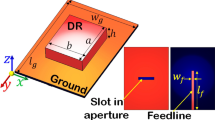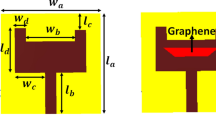Abstract
In this paper, the concept of mantle cloaking method uses to enhance the isolation between the two electrically close dipole antenna at low-terahertz (THz) frequencies, two strips of dipole antenna resonating at two different frequencies (2.05 THz and 2.65 THz), and separation between the dipoles antenna is \(0.08{\mathbf{\lambda }}\). We show the reduction of mutual coupling made by wrapping each dipole antenna with a thin graphene monolayer cuboid-shaped structure. The inherent graphene property provides the tuning of surface impedance, leading to the restoration of the matching condition and the antenna radiation pattern.












Similar content being viewed by others
References
Armstrong, C. M. (2012). The truth about terahertz. IEEE Spectrum, 49, 36–1. https://doi.org/10.1109/MSPEC.2012.6281131
Saptarshi, G., & Kumar, V. S. (2017). Polarization-insensitive single-/dual-band tunable absorber with independent tuning in wide frequency range. IEEE Transactions on Antennas and Propagation, 65, 4903–4908. https://doi.org/10.1109/TAP.2017.2731381
Alù, A., & Engheta, N. (2007). Cloaking and transparency for collections of particles with metamaterial and plasmonic covers. Optics Express, 15, 7578. https://doi.org/10.1364/OE.15.007578
Sarieddeen, H., Alouini, M., & Al-Naffouri, T. Y. (2019). Terahertz-band ultra-massive spatial modulation MIMO. IEEE Journal on Selected Areas in Communications, 37(9), 2040–2052. https://doi.org/10.1109/JSAC.2019.2929455
Alù, A., & Engheta, N. (2007). Plasmonic materials in transparency and cloaking problems: mechanism, robustness, and physical insights. Optics Express, 15, 3318. https://doi.org/10.1364/OE.15.003318
Monti, A., Soric, J., Alù, A., Bilotti, F., Toscano, A., & Vegni, L. (2012). Overcoming mutual blockage between neighboring dipole antennas using a low-profile patterned metasurface. IEEE Antennas and Wireless Propagation Letters, 11, 1414–1417. https://doi.org/10.1109/LAWP.2012.2229102
Correas-Serrano, D., Gomez-Diaz, J. S., Alu, A., & Alvarez-Melcon, A. (2015). Electrically and magnetically biased graphene-based cylindrical waveguides: Analysis and applications as reconFigurable antennas. IEEE Transactions on Terahertz Science and Technology, 99, 1–10. https://doi.org/10.1109/TTHZ.2015.2472985
Bernety, H. M., & Yakovlev, A. B. (2015). Reduction of mutual coupling between neighboring strip dipole antennas using confocal elliptical metasurface cloaks. IEEE Transactions on Antennas and Propagation, 63(4), 1554–1563. https://doi.org/10.1109/TAP.2015.2398121
Padooru, Y. R., Yakovlev, A. B., Chen, P. Y., et al. (2012). Analytical modeling of conformal mantle cloaks for cylindrical objects using sub-wavelength printed and slotted arrays. Journal of Applied Physics, 112(3), 034907–034919. https://doi.org/10.1063/1.4745888
Emadi, R., Safian, R., & Nezhad, A. Z. (2018). Use of an epsilon-near-zero region comprised of a graphene strip-silica stack for designing cloaking and reflection devices. IEEE Sensors Journal, 18(5), 1887–1894. https://doi.org/10.1109/JSEN.2017.2788180
Emadi, R., Safian, R., Nezhad, A. Z, & Barani, N. (2018). Robust multi-layer graphene-based plasmonic cloaking. In 2018 USNC-URSI Radio Science Meeting (Joint with AP-S Symposium), Boston, MA, pp. 145–146. https://doi.org/10.1109/USNC-URSI.2018.8602947.
Rizza, C., & Matekovits, L. (2019). Numerical investigation on graphene based mantle cloaking of a PEC cylinder. In 2019 IEEE international symposium on antennas and propagation and USNC-URSI radio science meeting, Atlanta, GA, USA, 2019, pp. 1321–1322. https://doi.org/10.1109/APUSNCURSINRSM.2019.8888586.
Hamzavi-Zarghani, Z., Yahaghi, A., & Matekovits, L. (2019). Dynamically tunable scattering manipulation of dielectric and conducting cylinders using nanostructured graphene metasurfaces. IEEE Access, 7, 15556–15562. https://doi.org/10.1109/ACCESS.2019.2894760
Hamzavi-Zarghani, Z., Yahaghi, A., & Ladislau, M. (2020). Electrically tenable mantle cloaking utilizing graphene metasurface for oblique incidence. AEU - International Journal of Electronics and Communications, 116, 153080.
Tripathi, S. K., Kumar, M., & Kumar, A. (2019). Graphene based tunable and wideband terahertz antenna for wireless network communication. Wireless Networks, 25, 4371–4381. https://doi.org/10.1007/s11276-019-02101-8
Zhang, B., Jornet, J. M., Akyildiz, I. F., & Wu, Z. P. (2019). Mutual coupling reduction for ultra-dense multi-band plasmonic nano-antenna arrays using graphene-based frequency selective surface. IEEE Access, 7, 33214–33225. https://doi.org/10.1109/ACCESS.2019.2903493
Author information
Authors and Affiliations
Corresponding author
Additional information
Publisher's Note
Springer Nature remains neutral with regard to jurisdictional claims in published maps and institutional affiliations.
Rights and permissions
About this article
Cite this article
Singh, A.K., Paras Enhancing the isolation between the strips of dipoles antenna at terahertz frequency with cuboid-shaped graphene layer. Wireless Netw 27, 3895–3902 (2021). https://doi.org/10.1007/s11276-021-02684-1
Accepted:
Published:
Issue Date:
DOI: https://doi.org/10.1007/s11276-021-02684-1




